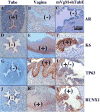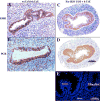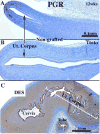Tissue interactions and estrogenic response during human female fetal reproductive tract development
- PMID: 29684808
- PMCID: PMC5993605
- DOI: 10.1016/j.diff.2018.04.002
Tissue interactions and estrogenic response during human female fetal reproductive tract development
Abstract
The role of tissue interactions was explored to determine whether epithelial differentiation within the developing human reproductive tract is induced and specified by mesenchyme in tissue recombinants composed of mouse vaginal mesenchyme + human uterine tubal epithelium (mVgM+hTubE). The tissue recombinants were grown in DES-treated ovariectomized athymic mice. After 2-4 weeks of in vivo growth, several vaginal specific features were expressed in the human tubal epithelium. The mesenchyme-induced effects included morphological change as well as expression of several immunohistochemical markers. Although the mesenchyme-induced shift in vaginal differentiation in the human tubal epithelium was not complete, the partial induction of vaginal markers in human tubal epithelium verifies the importance of mesenchymal-epithelial interactions in development of the human female reproductive tract. In a separate experiment, DES-induction of uterine epithelial progesterone receptor (PGR) and estrogen receptor 1 (ESR1) was explored in tissue recombinants composed of wild-type or Esr1KO mouse uterine mesenchyme + human fetal uterine epithelium (wt UtM+hUtE and Esr1KO UtM+hUtE). The rationale of this experiment was to determine whether DES-induction of PGR and ESR1 is mediated directly via epithelial ESR1 or indirectly (paracrine mechanism) via mesenchymal ESR1. DES-induction of uterine epithelial ESR1 and PGR in Esr1KO UtM+hUtE tissue recombinants (devoid of mesenchymal ESR1) formally eliminates the paracrine mechanism and demonstrates that DES induction of human uterine epithelial ESR1 and PGR is directly mediated via epithelial ESR1.
Keywords: Diethylstilbestrol; Estrogen receptor; Estrogenic response; Human female fetal reproductive tract; Mesenchymal-epithelial interactions; Progesterone receptor.
Copyright © 2018 International Society of Differentiation. Published by Elsevier B.V. All rights reserved.
Figures





Similar articles
-
Response of xenografts of developing human female reproductive tracts to the synthetic estrogen, diethylstilbestrol.Differentiation. 2017 Nov-Dec;98:35-54. doi: 10.1016/j.diff.2017.10.001. Epub 2017 Oct 4. Differentiation. 2017. PMID: 29102757 Free PMC article.
-
Molecular mechanisms of development of the human fetal female reproductive tract.Differentiation. 2017 Sep-Oct;97:54-72. doi: 10.1016/j.diff.2017.07.003. Epub 2017 Jul 29. Differentiation. 2017. PMID: 29053991 Free PMC article.
-
Neonatal uterine and vaginal cell proliferation and adenogenesis are independent of estrogen receptor 1 (ESR1) in the mouse.Biol Reprod. 2015 Mar;92(3):78. doi: 10.1095/biolreprod.114.125724. Epub 2015 Feb 4. Biol Reprod. 2015. PMID: 25653281
-
Roles of p63 in differentiation of Müllerian duct epithelial cells.Ann N Y Acad Sci. 2001 Dec;948:9-12. doi: 10.1111/j.1749-6632.2001.tb03982.x. Ann N Y Acad Sci. 2001. PMID: 11795399 Review.
-
Estrogen receptor-alpha mediates the detrimental effects of neonatal diethylstilbestrol (DES) exposure in the murine reproductive tract.Toxicology. 2004 Dec 1;205(1-2):55-63. doi: 10.1016/j.tox.2004.06.046. Toxicology. 2004. PMID: 15458790 Review.
Cited by
-
Development of the human female reproductive tract.Differentiation. 2018 Sep-Oct;103:46-65. doi: 10.1016/j.diff.2018.09.001. Epub 2018 Sep 6. Differentiation. 2018. PMID: 30236463 Free PMC article. Review.
-
Novel non-synonymous and synonymous gene variants of SRD5A2 in patients with 46,XY-DSD and DSD-free subjects.PLoS One. 2025 Mar 5;20(3):e0316497. doi: 10.1371/journal.pone.0316497. eCollection 2025. PLoS One. 2025. PMID: 40043094 Free PMC article.
-
Reproductive tract biology: Of mice and men.Differentiation. 2019 Nov-Dec;110:49-63. doi: 10.1016/j.diff.2019.07.004. Epub 2019 Sep 6. Differentiation. 2019. PMID: 31622789 Free PMC article. Review.
-
Immunohistochemical expression analysis of the human fetal lower urogenital tract.Differentiation. 2018 Sep-Oct;103:100-119. doi: 10.1016/j.diff.2018.09.004. Epub 2018 Sep 19. Differentiation. 2018. PMID: 30287094 Free PMC article.
-
SIX1 cooperates with RUNX1 and SMAD4 in cell fate commitment of Müllerian duct epithelium.Cell Death Differ. 2020 Dec;27(12):3307-3320. doi: 10.1038/s41418-020-0579-z. Epub 2020 Jun 22. Cell Death Differ. 2020. PMID: 32572167 Free PMC article.
References
-
- Bern HA, Mills KT, Ostrander PI, Schoenrock B, Graveline B, Plapinger L. Cervicovaginal abnormalities in BALB/c mice treated neonatally with sex hormones. Teratology. 1984;30:267–274. - PubMed
-
- Bern HA, Talamantes FJ. Neonatal mouse models and their relation to disease in the humal female. In: Herbst A, Bern HA, editors. Developmental Effects of Diethylstilbestrol (DES) in Pregnancy. Thieme Stratton Inc.; New York: 1981. pp. 129–147.
-
- Cunha GR. Stromal induction and specification of morphogenesis and cytodifferentiation of the epithelia of the Mullerian ducts and urogenital sinus during development of the uterus and vagina in mice. J Exp Zool. 1976;196:361–370. - PubMed
Publication types
MeSH terms
Substances
Grants and funding
LinkOut - more resources
Full Text Sources
Other Literature Sources
Research Materials
Miscellaneous

